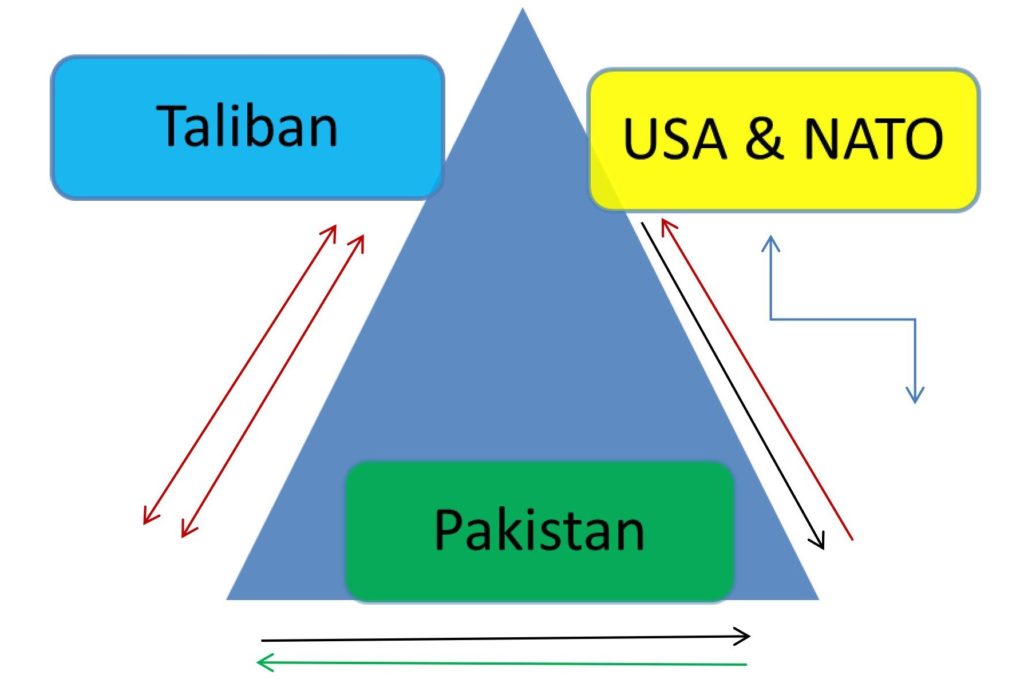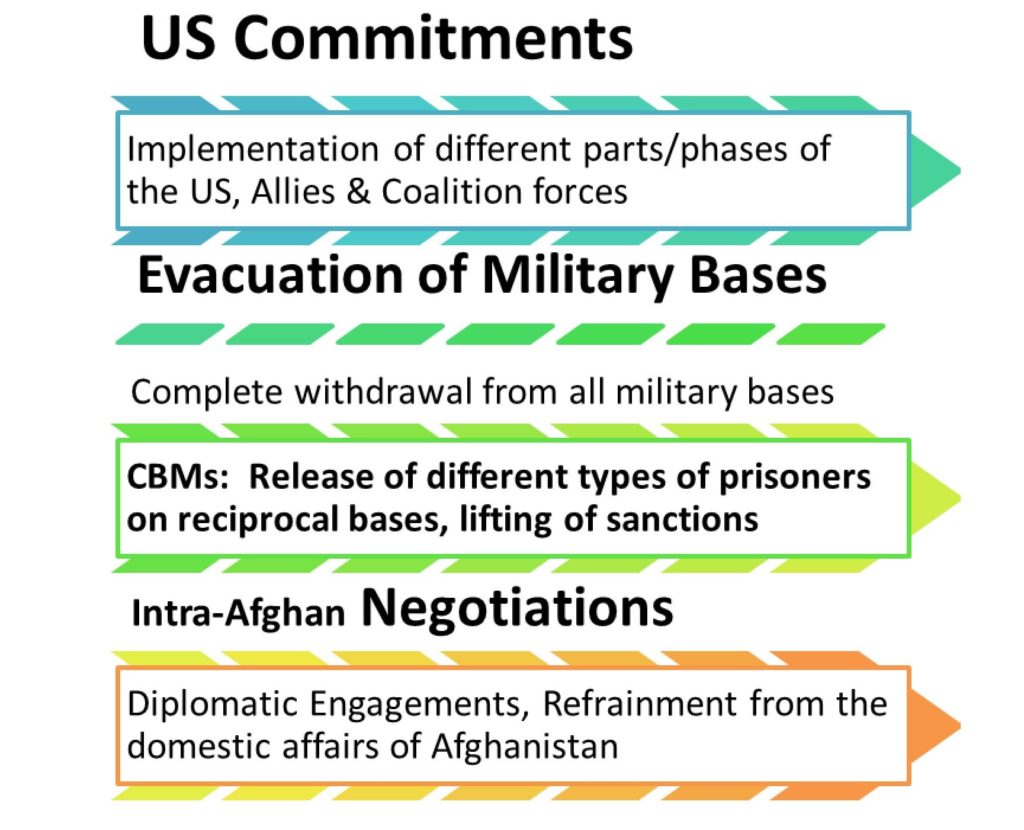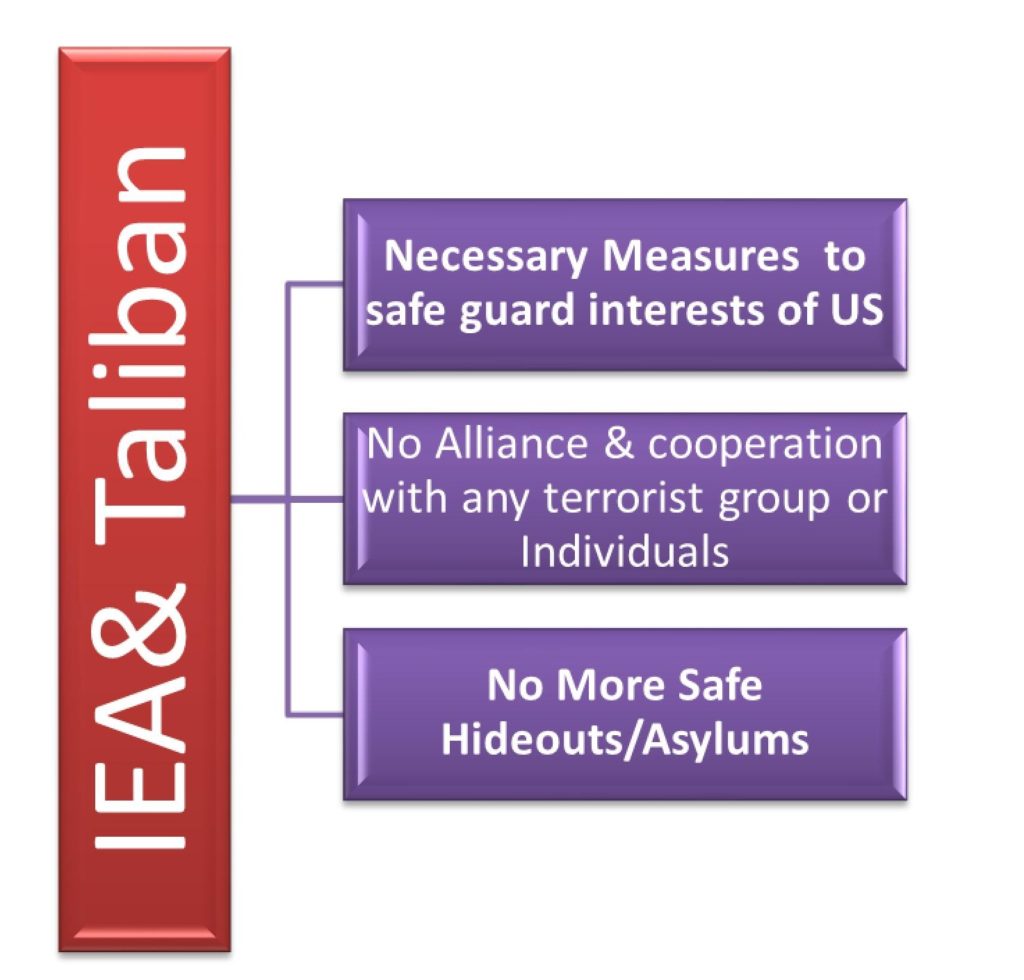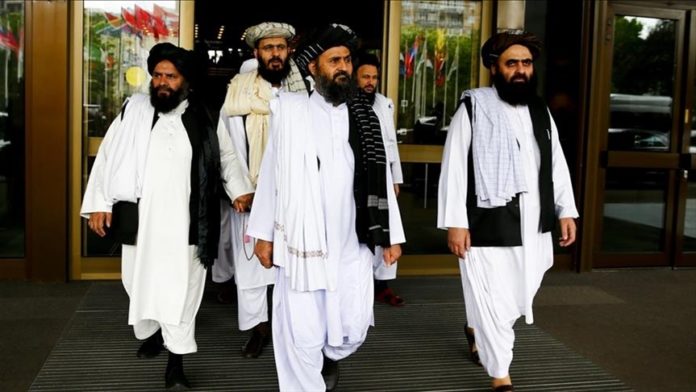War “hysteria” has now dashed in Doha. Warmongering of 20 years, loss of more than US$ 750 billion, unlimited collateral damages, brutal killings, bombs, blasts, deadlocks, miseries and uncertainties, a historic peace agreement has now been signed between the US and Taliban (once projected as angles of God, propagated worse terrorists/enemies of humanity and again accepted/recognized as a necessary political entity) for achieving desirable peace and harmony in Afghanistan. After 18 months of dialogue, diplomacy and 2 decades of war, the Taliban and the United States have now signed a four page agreement aimed at paving the way for peace in Afghanistan and the departure of foreign troops.
The historic peace deal titled “Agreement for Bringing Peace to Afghanistan” outlines a series of interrelated promises & pledges and commitments from the US and the Taliban aiming to reduce troop levels, counter-terrorism, and the intra-Afghan dialogue aimed at bringing about “a sustainable and inclusive ceasefire.”
“The peace agreement outlines a 14 month timetable for the withdrawal of all military forces of the United States, its allies, and Coalition partners, including all non-diplomatic civilian personnel, private security contractors, trainers, advisors, and supporting services personnel”.
Main Players: An Iron-Triangle Approach
In real political terms it has been enforced because of certain political compulsions (US President Trump desires to use it as its biggest strategic victory in its second term presidential campaign), Taliban readiness of political persuasions instead of futile war, Pakistan’s determination to secure its eastern border by having peace in Afghanistan, Iran wants to act as good-boy to win some admiration form the West and last but not least, China plans its out-reach to Central Asia through massive infrastructural development and industrialization in Afghanistan. Russia has been trying its best to resolve the issue of Afghanistan on regional basis. In this regard, numerous regional conferences and dialogues have been arranged by Russia in the near past. Even Turkey “Heart of Asia” conference has been instrumental to resolve the burning issue of Afghanistan in the past. Moreover, the Republic of Uzbekistan has been very vocal to achieve peace and harmony in Afghanistan through regional engagements.
Unfortunately, the soil of Afghanistan has been misused by the regional main stakeholders and global movers & shakers through proxies. Humanity has been at the receiving end and “War Theater” has also been financed by various state and non-state actors in Afghanistan since 1980. 9/11 incident changed its strategic position. Afterwards, there has been unstoppable flood of drone attacks, combats, conspiracies and suicidal attacks in Afghanistan. Its regional repercussions put many countries in the line of fire. Due to which Pakistan has been in the cross-firing on various fronts. Its eastern & western borders have become faulty. Thanks to armed forces of Pakistan which successfully protected the vested interests.

So, forces of convergence outplayed forces of divergence and worked jointly to reach a durable peace agreement. The government of Pakistan and its allied forces once again played a decisive role to bring Taliban on the table of negotiations and dialogue. US, Taliban and Pakistan have been three key players to end bloodshed in Afghanistan. Pakistan has now become “equalizer” in the region by undermine the role of India in Afghanistan.
The US and the Taliban have signed an “agreement for bringing peace” to Afghanistan after more than 18 years of conflict.
Salient Features
A comprehensive peace agreement has four operative parts which are given below as:-
a. It is agreed that through the guarantees and enforcement mechanisms soil of Afghanistan will be prevented from any group or individual against the security of the United States and its allies.
b. It is agreed that through guarantees, enforcement mechanisms, and announcement of a timeline for the withdrawal of all foreign forces from Afghanistan will be given.
c. Third phase is very important that after the announcement of guarantees for a complete withdrawal of foreign forces and timeline in the presence of international witnesses, and guarantees and the announcement in the presence of international witnesses that Afghan soil will not be used against the security of the United States and its allies, the Taliban will start “intra-Afghan negotiations” with Afghan sides on March 10, 2020.
d. The last phase of this historic agreement will be based on a sustainable, functional and inclusive ceasefire will be an item on the agenda of the intra-Afghan dialogue and negotiations. During the proposed intra-Afghan negotiations the participants of intra-Afghan negotiations will discuss the date and modalities of a permanent and comprehensive ceasefire, including joint implementation mechanisms, which will be announced along with the completion and agreement over the future political roadmap of Afghanistan.
Implantation Phase
| Different Phases of Implementation | Mechanism |
| Withdrawal | US committed to withdraw from Afghanistan all military forces of the United States, its allies, and Coalition partners, including all non-diplomatic civilian personnel, private security contractors, trainers, advisors, and supporting services personnel |
Time Frame | 14 Months |
Diversified & Integrated Measures | |
Crucial First 135 Days | Reduction of US troops to 8600 & proportionate reduction in the number of its allies and Coalition forces. |
Military Bases | Withdrawal of the US & its allies, and the Coalition forces from five military bases. |
Complete Withdrawal | US its allies and the Coalition will complete withdrawal of all remaining forces from Afghanistan within the remaining nine and a half months. |
Remaining Military Bases | US its allies and the Coalition will withdraw all their forces from remaining bases. |
Confidence Building Measures | US will start immediately to work with all relevant sides on a plan to expeditiously release combat and political prisoners as a confidence building measure with the coordination and approval of all relevant sides. |
| Exchange of Prisoners | US will release 5000 prisoner belonging to Taliban & Taliban will release 1000 prisoners belonging to the US, allies and coalition forces by March 10, 2020. Remaining prisoner will be released subsequently. |
Intra-Afghan Negotiations | With the start of Intra-Afghan Negotiations (IANs) the US will initiate an administrative review of current U.S. sanctions and the rewards list against members of the Islamic Emirate of Afghanistan, Taliban till August 27, 2020. |
Diplomatic Engagement | The US States will start diplomatic engagement with other members of the United Nations Security Council and Afghanistan to remove members of the Islamic Emirate of Afghanistan from the sanctions list with the aim of achieving this objective by May 29, 2020. |
US Refrainment | The US & allies will refrain from the threat or the use of force against the territorial integrity or political independence of Afghanistan or intervening in its domestic affairs. |

b. The Islamic Emirate of Afghanistan, Taliban
“Taliban will take all possible measures/steps to prevent any group or individual, including al-Qa’ida, from using the soil of Afghanistan to threaten the security of the United States and its allies. It include commitments that the Taliban will instruct/advise its followers/friends/ members not to cooperate with groups or individuals threatening the security of the United States and its allies and that it will prevent any group or individual in Afghanistan from threatening the security of the United States and its allies, and will prevent them from recruiting, training, and fundraising and will not host them in accordance with the commitments in this agreement.”
| Different Phases of Implementation | Mechanism |
| Necessary Measures | Taliban will take various steps to prevent any group or individual, including al-Qa’ida, from using the soil of Afghanistan to threaten the security of the United States and its allies |
| No alliance with any terrorist organization | Through its conduct, IEA & Taliban will assure the US and allies to maintain distance from groups & individuals threatening the security of the United States and its allies. |
| No Links with Terrorist | IEA & Taliban will stay away from any group or individuals recruiting, training, and fundraising against the security of the US and allies. |
| No More Safe Hideouts/Asylums | IEA & Taliban will follow the international migration law and the commitments for any asylum. |
| No Visa | IEA & Taliban will not provide visas, passports, travel permits, or other legal documents to those who pose a threat to the security of the United States and its allies to enter Afghanistan. |

c. Efforts of International Recognition & Diplomatic Engagement
| Different Phases of Implementation | Mechanism |
Recognition | The US will request the recognition and endorsement of the United Nations Security Council for this agreement. |
Positive Relations | The US & IEA and Taliban seek positive relations even after intra-Afghan dialogue and negotiations. |
| Economic Cooperation | The US will seek economic cooperation for reconstruction with the new post-settlement Afghan Islamic government as determined by the intra-Afghan dialogue and negotiations but will not intervene in its internal affairs. |
US Secretary of State Pompeo
After the signing of the peace deal the US Secretary of State Pompeo termed it as a hopeful moment, but it’s only the beginning,” President Donald Trump immediately responded and told reporters at a White House news conference in Washington that he would be meeting personally with Taliban leaders in the not too distant future” following the signing of the agreement. It is expected that Taliban leaders and Trump could meet as early as next week.
The peace deal was signed by US special envoy Zalmay Khalilzad and Taliban political chief Mullah Abdul Ghani Baradar with US Secretary of State Mike Pompeo as a witness.
Important Statements
In a speech, Mr Pompeo urged the militant group to “keep your promises to cut ties with al-Qaeda”. Mr Baradar said he hoped Afghanistan could now emerge from four decades of conflict. “I hope that with the withdrawal of all foreign forces from Afghanistan the Afghan nation under an Islamic regime will take its relief and embark on a new prosperous life,” he added. Mr Ghani said the country was “looking forward to a full ceasefire”. The government said it was ready to negotiate with the Taliban.
International Reactions
UN Secretary-General Antonio Guterres stressed “the importance of sustaining the nationwide reduction in violence, for the benefit of all Afghans”. NATO Secretary-General Jens Stoltenberg stressed the need to be united and together to achieve the desired goals of peace and harmony. UK Defence Secretary Ben Wallace welcomed this small but important step towards the chance for Afghans to live in peace, free from terrorism.
There were nine rounds of on-again, off-again talks in Doha where the Taliban maintains an office which began in 2018. The U.S. and Taliban had reached an agreement last summer, but President Trump walked away from those talks after a U.S. service member was killed in a September car bombing in the Afghan capital, Kabul.
Grey Areas
Although it is a historic peace agreement but still it has lots of grey areas or red lines which need to be rectified as soon as possible.
Conclusion
Afghanistan the land of mountains and militias is passing through a difficult time of its history but thanks God, after signing of peace agreement in Doha, chances of peace and harmony are ever bright. Ultimately, doves of peace and stability fly high and Afghanistan the epicenter of war lord garrisons and guerrillas has fed-up with the ongoing war in its country.
Throughout ups and downs of regional history, Afghanistan has been famous for its renowned onward struggle, rebellious national character, and unending resistance towards aggressors/invaders/attackers which has now reached to another flashpoint of its proud history and seems to be ready for greater reconciliation, conflict resolution, dialogue and diplomacy. Peace agreement between the US and Taliban is its prime example. Holding of different meetings behind the scene, surge in diplomatic efforts, conducting of regional and international conferences and above all active role of all the main power brokers in the region i.e. Pakistan, Uzbekistan, Iran, Russia, China and the international players like allied forces, NATO, the US, UK and the EU has reached to its logical conclusion in shape of Doha Peace Agreement.
Every country has its own unique traits of civilization which cannot be compared to any other country. Throughout history Afghanistan has had been labeled as undefeatable entity. To bring peace in Afghanistan has been a complicated issue which has now overcome through complete overhauling in collective war hysteria and expansionary designs. War and destruction bring more massacres and miseries because in war no one is winner but all losers. Political means, dialogue, diplomacy and deterrence would be ideal to resolve any conflicting realties. It is now evident that terrorism is an anti-human tool and attack on independent country sovereignty is again anti-international laws.
The government of Pakistan and armed forces has been doing their levels best to support the West and especially the US to curb the terrorist incidents and bring peace in Afghanistan through peaceful engagements and dialogue. The human losses, financial damages and socio-economic alienation from the onslaught of war against terrorism all reflected that the government and armed forces were faithful to universal causes i.e. respect for humanity, interfaith harmony, tolerance, peace and above all brotherhood.
Afghanistan has been hub of regional and international power game. Hot pursuits of socio-economic dominance, geo-political superiority and above all geo-strategic presence have already made Afghanistan a flash-point of regional and international power politics. New chess-board has been staged in and around Afghanistan even after the successful inking of US-Taliban peace agreement in Doha. New guidelines, reformation of foreign policies and last not the least, strategic rethinking has been reshaped and remerged among the power brokers and main stakeholders. Hectic efforts show that time is short and interests are too big to handle with ease.
The government of Pakistan needs political stability in its Eastern Boarders. Many mega energy projects mainly Turkmenistan, Afghanistan, Pakistan and India Gas Pipeline (TAPI), CASA-1000, electricity imports from Tajikistan and other Central Asian Countries have been delayed and dysfunctional due to deteriorating law and order situation in Afghanistan. The best utilization of Gwadar Sea-Port cannot be achieved until there is durable peace in Afghanistan. Moreover, peace in Afghanistan may strengthen our national security apparatus and give strategic depth too. Pakistan has the longest adjoining border with Afghanistan. It is the natural window to Afghan needs as a trade corridor and for essential provisions for survival. It is gate-way to Central Asian Region too.
Peace in Afghanistan would be instrumental for Iran to initiate lots of energy projects with Central Asian Countries. It would enhance bilateral or trilateral trade volumes among Iran and other countries of the region. It would enhance infrastructure and transportation facilities in the region which would definitely bring socio-economic prosperity throughout the region.
China has merged a new powerful stakeholder in the region and especially in central Asian region. Its diversified economic integration and collaboration within the region heavily relies on the peace in Afghanistan. Its CPEC has become a game & fate changer in the region. Peace in Afghanistan would also bring geo-strategic cushion for Chinese government in absence of NATO, allied forces and especially US in the region. China believes that US will like to maintain its influence over Afghanistan even after withdrawing its troops. China believes that Afghan ethic groups and political parties should decide on what form of government they want, based on their culture, tradition and domestic conditions.
Afghanistan has been remained central point of all the Central Asian Countries foreign policies since their independence. It is crystal clear that absence of a stable and functional government in Afghanistan has been creating economic and security challenges for the Central Asian countries. Central Asia is blessed with huge reservoirs of oil and gas which can be imported to regional countries. They have already finalized agreements of energy import with many regional countries namely, China, Iran, Pakistan, Afghanistan and India. New hydroelectric stations in Tajikistan and Kyrgyzstan producing electricity to be marketed in Afghanistan, Pakistan and India are supposed to be prime examples. The TAPI (Turkmenistan-Afghanistan- Pakistan-India) gas pipeline also has not progressed due to continued political instability and deteriorating law and order situation in Afghanistan.
The ADB study identified 52 potential road corridors through Afghanistan connecting Tajikistan, Uzbekistan, and Turkmenistan with five seaports in Pakistan and Iran. Thirty-one of these roads would link to Pakistan ports and the other twenty-one to ports in Iran. Furthermore, report says that the total distance of the combined corridors is about 13,586 kilometers or 8,444 miles. It is estimated that the corridors are to originate in Dushanbe for Tajikistan, Tashkent for Uzbekistan, and Ashgabat for Turkmenistan and then enter Afghanistan from Tajikistan at Shirkhan Bandar or Hairatan, from Uzbekistan at Hairatan and from Turkmenistan at Aqina or Torghandi. The corridors exit Afghanistan from Nangargar province to Pakistan’s ports at Torkham leading to Karachi/Port Qasim or via Afghanistan’s Kandahar province at Spin Boldak (leading to Karachi or Gwadar.
The ADB claimed that after completion of these corridors regional trade would increase by 160 percent and combined transit trade would grow by 113 percent. Total exports among the participating countries by 2020 would increase by 25 percent or $5.8 billion and total imports would grow by 16 percent or $6.7 billion. US-Taliban peace agreement will have multiplier effects in the days to come and it is estimated that the combined GDP of the regional countries in the region will increase by over 5-8 percent per year during the next five years.
Undoubtedly, spoilers are still existed in and out of Afghanistan. Now it is the leadership test of both Taliban and the government of Afghanistan to start a meaningful intra-Afghan dialogue by sharing the spirits of forgiveness, accommodation, straightforwardness and conflict resolution. United States would have to mobilize the support and resources for post-conflict reconstruction of Afghanistan and return of refugees from Pakistan.
We must also appreciate the US President Trump’s anti-war stance. Despite of war of tug he presented branch of olive to North Korea, Afghanistan and even Iran. He drastically changed the US’s concept of international engagement through wars. Although, the US Taliban peace agreement in Doha must have some political motivations but one must not forget that peace should always be welcomed because humanity and its survival should not be in the conflict zone anymore.





